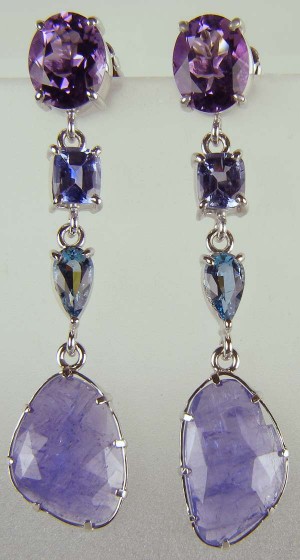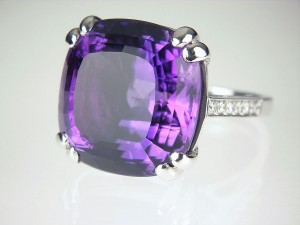Amethysts for February
Amethyst is a variety of quartz (silicon dioxide). As the birthstone for February, it is said that it can strengthen relationships and give courage and Ancient Greeks believed it prevented drunkenness. It is a popular gemstone in jewellery because of its beautiful purple colour, which can range from pale pinkish-purple to deep purple tinged with either magenta or blue, and its relative affordability. Its colour is caused by trace impurities of iron in the crystal lattice.
Amethysts that are blue tinged are called ‘gaslight’ and have an unusual blue glint which is seen when the otherwise purple stone is tilted, akin to the colour of a glass flame. ‘Gaslight’ amethysts come from Zambia, but there are many important sources of amethyst worldwide; Brazil and Uruguay are major commercial producers of gem-quality amethyst.
One very important feature of amethyst that is little known by vendors and buyers alike is that this gem will fade when exposed to strong daylight. Antique amethyst jewellery that has been worn for years is typically pale and faded, with the colour intensity far below that it possessed when first purchased. If antique jewellery is set with amethysts that are dark and richly coloured, I am a little wary and have to decide whether the jewellery is genuinely old and been kept in a box, unworn for many years, or whether it is a reproduction.
Nowadays, the biggest problem that I face when buying amethysts is that approximately 90% of new amethysts on the market are man-made. It is very easy to make synthetic quartz in a variety of colours to imitate other quartz gemstones such as citrine or smoky quartz and to copy the colours of more expensive gems like aquamarine or even the turquoise hue of Paraiba type tourmalines. The latter are used in cheap replica jewellery, or to deceive the unwary. When I am considering buying amethysts, I have to look very closely at the inclusions in the stone to make sure that the gems are natural. Natural amethyst has distinctive colour zoning and may contain small golden brown needle- like crystals of geothite or silver inclusions of hematite (both iron rich minerals).
Amethyst is a relatively delicate gemstone, with a hardness of seven on Moh’s scale of hardness (which ranges from one to ten, with ten being the hardest). I advise my customers to wear amethyst rings with care, so as not to chip or scratch them. Unfortunately they aren’t suitable to be worn all the time, for example in something like an engagement ring and are really considered only for dress rings.
At Just Gems, we have a variety of beautiful jewellery made using amethysts, view our gallery or get in touch to find out more.


